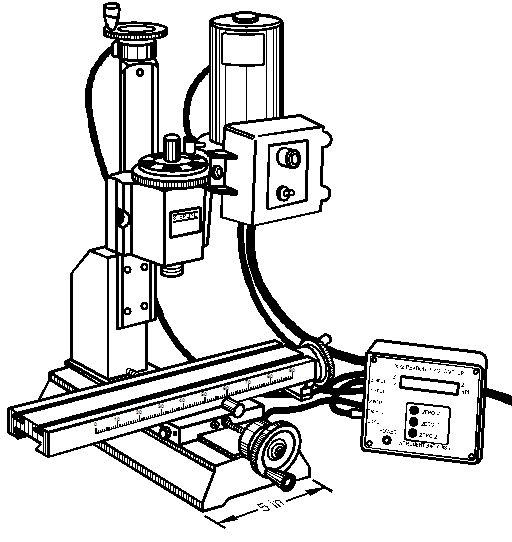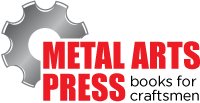- Acknowledgements
- Introduction
- Chapter 1: Measurement Tools, Layout & Job Planning
- Chapter 2: Basic Hand Tools
- Chapter 3: Filing & Sawing
- Chapter 4: Grinding, Reaming, Broaching & Lapping
- Chapter 5: Drills & Drilling Operations
- Chapter 6: Threads & Threading
- Chapter 7: Turning Operations
- Chapter 8: Milling Operations
- Chapter 9: Fastening Methods
- Chapter 10: Why Steel Hardens
- Chapter 11: Safety & Good Shop Practices
- Chapter 12: Other Shop Know-how
- Appendix I: Sharpening Steel Lathe Tools
- Appendix II: Surface Speed Table & Cutting Tool Selector Chart
- Appendix III: Decimal Equivalents of Fractional, Letter & Metric Drills
- Glossary
- Index
Chapter 8
Milling Operations
Stupidity is the basic building block of the universe.
—Frank Zappa
Introduction
Unlike lathes, which have been known for thousands of years, milling machines are less than two hundred years old. Because they require much more power than hand-driven lathes, their introduction had to wait for the invention of industrial water and steam power. Also, all their mechanical components had to first be made available, such as accurately fitted slides, large castings to resist cutting forces, calibrated leadscrews, and hardened steel cutting tools.
Eli Whitney is credited with inventing the first milling machine about 1818, but the knee-and-column support arrangement of the universal milling machine of Joseph A. Brown (later of Brown and Sharpe) dates from 1862 and marks an important step in the machine’s development. During the last half of the nineteenth century, milling machines gradually replaced shapers and planers which have lathe-type, single-point tool bits that move over the work in a straight line and scrape off metal one stroke at a time. Milling machines, with their continuous cutting action, not only remove metal faster than shapers and planers, they perform additional operations such as cutting helices for gears and twist drills. Today, milling machines greatly outnumber shaping and planing machines. Americans in New England and later the mid-west continuously added features leading to the modern milling machine.
Another important development came in the 1930s when Rudolph Bannow and Magnus Wahlstrom brought out the Bridgeport-style vertical milling machine. This design offers versatility and economy in place of the higher metal removal rates of traditional horizontal milling machines. Because of this versatility, there are more Bridgeport-style mills in existence today than any other milling machine design. Horizontal mills are now usually reserved for production applications where high metal removal rates on identical parts are needed, not prototyping and short runs. Bridgeport-style machines are also called knee-and-column machines and turret mills. The key features of these machines include:
- Knee-and-column support for the milling table, which provides vertical motion of the work with respect to the tool.
- Saddle which supports the table to provide in-and-out motion from the vertical column.
- One-piece tool head which holds the motor, drive pulleys, and spindle.
- Sliding overarms or rams were eventually added to allow the tool head to be moved in or out with respect to the vertical column. Some machines have provisions for the tool head to be tilted side to side or back to front.
The Bridgeport-style machine offers many advantages over the older horizontal milling machine design:
- The biggest advantage is the quill’s ability to advance and retract the cutter easily without cranking to raise and lower the milling table. This speeds production and reduces operator fatigue. The retractable quill lets the operator quickly withdraw the tool to clear chips from a hole or check its progress. Tactile feedback through the quill feed handle or handwheel also tells the machinist how the tool is cutting and lets him optimize hand feed with less danger of tool breakage. Vertical table movement is still available for high-accuracy depth adjustment or when more force on the tool is required.
- The second largest advantage is the Bridgeport-style machine’s ability to make angle cuts. With the horizontal milling machine, either the milling cutter is made on an angle, or the work must be positioned at an angle to the spindle axis. With the Bridgeport-style machine the operator merely needs to tilt the spindle to make an angle cut. Of course, the Bridgeport can also use an angled cutter or mount the work on an angle.
- Vertical milling machines must use smaller cutting tools than horizontal mills because they have less rigid, less massive castings, and lower horsepower motors. Still, they can accomplish the same end results as the horizontal mill, just more slowly.
- Vertical milling machines are less complex than horizontal machines because the one-piece tool head eliminates the need for complicated gearing inside the vertical column.
- Bridgeport-type milling machines usually have 1 to 5-horsepower motors, and smaller castings than most horizontal mills. Because of this they generally cost less.
- Knee-and-column mills offer versatility and economy in place of the high metal removal rates of traditional horizontal milling machines.
- Bridgeport-style mills provide better visibility of the end mill cutter.
There are between 15 and 36 milling machine designs or styles, depending on who is counting, but the focus of this study is the Bridgeport-style vertical knee mill because they are most often used in shops doing prototyping and R&D work. They outnumber all other designs combined. This design has so much to offer that it has been copied in every industrialized country. At one time there were no less than thirteen separate Spanish companies building Bridgeport-style mills. A working knowledge of a Bridgeport-style vertical milling machine also provides a good start for operating any other style milling machine.
Lathes and mills are complementary machines. While lathes rotate the workpiece and produce a cylindrical cut, milling machines move work into a rotating cutter and make a straight line cut. Lathes and mills are both capable of boring large-diameter holes, but mills are better at placing holes anywhere on the surface of the work. Although one can sometimes make do with just a lathe or mill, a well-equipped shop must have both machines.
The lathe cutting tool is in continuous contact with the work and so makes a continuous cut. Milling machines are just the opposite. They use multi-tooth cutting tools and their cutting action is intermittent as each tooth takes a bite. Metal is removed in small individual chips. Unlike lathe cutting tools, end mills, the most common cutting tool for Bridgeport-style mills, cannot be sharpened freehand because they must be perfectly symmetrical. Sharpening them requires special fixtures and shaped grinding wheels. Smaller shops send their cutters out for sharpening.
Adding a digital readout (DRO) is a great convenience to any milling machine. It reduces the need to repeatedly stop the mill to make measurements and lowers the chance of errors. When reset to zero, the DRO displays the exact displacement from a reference point on the workpiece making it possible for the operator to work directly with the dimensions on his working drawing.
For production applications, there are large, expensive milling machines with three or more axes under computer control. Some machines perform all operations including automatic tool changing. However, today there is an intermediate step between a manual mill and a fully automated one. Adding a computer, digital readouts, and actuators to the X- and Y-axes of a Bridgeport-style mill does this. Not only can this enhanced machine tirelessly perform all its existing repetitive functions, it also has added new capabilities. Now the mill can engrave (drive the tool to cut numbers and letters in various sizes and fonts), cut radii and angles without a rotary table, make islands, pockets, and cut ellipses, and frames. Entering the position, diameter and number of holes, automates cutting a bolt-hole pattern; the system does the math. The computer can also automatically compensate for the reduced diameter of resharpened milling cutters, saving time and money. The system can be manually programmed through its control panel, use stored programs, “learn” new tasks by memorizing a series of manual operations as the operator makes the first part, or accept files from CAD programs.
In this chapter we will study two mills, the Sherline miniature milling machine and the classic, full-sized Bridgeport® by Hardinge®. First, we will look at each machine, then examine its major components and study each of its adjustments and controls. Next, we will look at milling machine cutting tools and accessories, and learn its step-by-step operation. Finally, we will review milling machine safety issues.
Section I – Modern Milling Machines
Here are two typical quality machines from small to medium size:
- Sherline Products Incorporated Model 5400-DRO Miniature Vertical Milling Machine, Figure 8–1, has a 2.75- by 13-inch worktable, which offers two T-slots and rides on precision-machined dovetailed slides with adjustable gibs. The spindle has permanently lubricated bearings with an adjustable preload driven by a one-third horsepower variable-speed SCR drive DC motor. The motor accepts incoming current from 100 to 240 VAC, 50 or 60 Hz and automatically outputs 90 VDC to the motor so it can be operated anywhere in the world without the need for a separate transformer or rewiring. Speed is continuously variable from 70 to 2800 rpm without gear or belt changes. A second pulley position is available for providing additional torque at low rpm. Its three laser-engraved handwheels are calibrated in 0.001-inch increments or 0.01 mm in metric versions. Both the X- and Y-axes have anti-backlash feed screws. Like Sherline lathes, their milling machines have a #1MT spindle and a ¾-16 spindle nose thread. This model’s overall dimensions (H3W3D) are: 21315312 inches; travel X-axis: 9 inches, Y-axis: 5 inches and Z-axis: 6.25 inches. The headstock can be rotated up to 90º right or left for angled or horizontal milling. The machine pictured has a DRO for all three axes and also displays spindle rpm. Like larger mills, the DRO can be set to zero at the push of a button. This machine, including DRO, sells for $1005 and has a shipping weight of 37 lb. Additional optional Sherline column upgrade kits allow headstock column rotation (90° left/right), column pivot (front/back), column swing (90° left/right) and 5.5 inches of column travel (in/out) much like full-size Bridgeport-style mills. Sherline offers dozens of accessories including end mills, milling cutters, flycutters, boring heads, tilting tables, rotary tables, chucks, knurling tools, ball turners and collets. Although these machines are small and relatively inexpensive, they are capable of precision work. Sherline manufactures its products in Vista, California. Sherline’s website, www.Sherline.com, has complete instructions, parts lists, and drawings on their tools. There are also dozens of examples of projects made on these lathes as well as clever enhancements owners have devised.

Figure 8–1. Sherline Model 5400-DRO Miniature Vertical Milling Machine.

